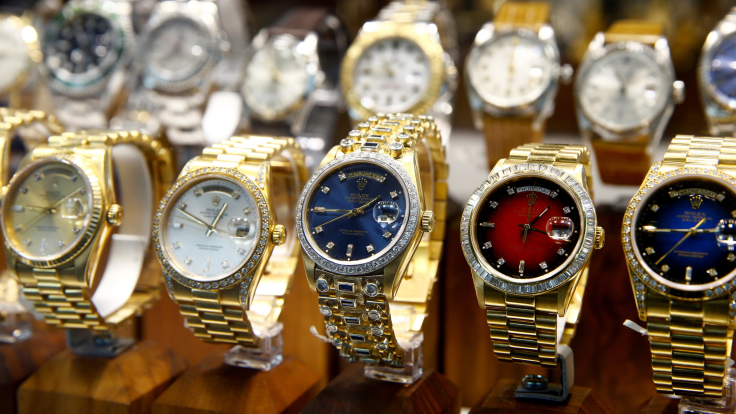Rolex Prices Just Fell Off a Cliff — Here's Why Experts Say That's Good News

KEY POINTS
- Rolex resale prices have dropped up to 30 per cent from pandemic peaks.
- Analysts call it a healthy correction after years of speculative hype.
- Discontinued and rare models remain steady and could rebound.
After years of soaring prices, endless waiting lists and online frenzy, the once red-hot luxury watch market is losing its shine.
The biggest name of all, Rolex, long seen as the crown jewel of Swiss watchmaking, is now facing what collectors are calling a 'Rolex price crash'.
Prices for many of its most sought-after models have fallen sharply, shaking confidence among buyers and investors who once treated timepieces like blue-chip stocks.
From the Submariner to the Daytona, watches that were fetching two, three or even four times their retail price during the pandemic boom are now being sold for much less.
Dealers say the frenzy that fuelled record profits between 2020 and 2022 has finally cooled, leaving behind a more cautious and selective market.
Yet experts insist this is not a collapse, but a long-overdue correction. The speculative bubble that inflated during lockdown, when travel-starved buyers turned to luxury goods and social media influencers glorified watch investing, has simply run its course.
'What we're seeing is a return to reality,' said one Swiss industry analyst. 'The market is normalising after years of irrational exuberance.'
A Correction, Not A Crisis
According to analysts at Box and Docs UK, a surge in grey-market supply is driving prices down. Dealers and resellers who hoarded watches during the boom years are now struggling to move inventory as demand cools. 'Supply is outpacing demand — for now,' the firm said in its latest market report.
Economic tightening and rising interest rates have also cooled spending on luxury goods. Fewer buyers are chasing status symbols, and the so-called 'Instagram effect' of flaunting high-end watches online has faded.
'Dealers who were sitting on mountains of stock during the boom are now facing thinner margins,' the report added. 'But this is not the end of Rolex. It is simply a return to healthy market behaviour.'
The Bubble That Had To Burst
Between 2020 and 2022, Rolex prices climbed to extraordinary levels as global lockdowns, cheap credit and limited production fed a speculative frenzy.
A Tiffany Blue Oyster Perpetual that retailed for about £5,000 sold for over £30,000 on the secondary market. The 'John Mayer' Daytona, listed at £32,000, fetched more than £120,000.
According to Oakleigh Watches UK, the market was 'both unrealistic and unsustainable'. 'People were paying ridiculously inflated prices for watches that were not that rare,' a company representative said. 'When collectors realised there were dozens of unworn examples available online, the bubble burst.'
By late 2023, reality began to set in. As more watches hit the market, sellers undercut each other to move stock. Prices for mass-produced models such as the Submariner and GMT-Master II have since fallen by as much as 30 per cent from their peak.
Three Tiers Of Value
Experts now classify Rolex models into three categories. The first includes current-production, highly speculative watches like the Submariner and Daytona, which saw the steepest declines. The second covers discontinued references and genuinely rare models that have dipped only slightly, typically 5–10 per cent. The third consists of classic but underappreciated pieces that have fallen more than they should have.
'The classic 36mm Explorer is a good example,' Oakleigh Watches said. 'It was tipped to reach £10,000 but now sells for closer to £6,000. There's no reason it should have dropped that far, so for collectors it represents real value.'
A Buyer's Market Emerges
For serious collectors, the downturn may be the best news in years. The correction has cooled the speculative heat and brought prices closer to intrinsic value.
'Collectors love corrections,' Box and Docs noted. 'The best time to buy quality is when the hype dies down.'
Dealers also report stronger interest in the pre-owned sector, where trusted platforms like Watchfinder and Chrono24 are seeing renewed activity. 'After years of inflated pricing, the market is finally accessible again,' said a London-based vintage dealer.
Despite the volatility, Rolex remains resilient. Authorised dealers still manage waiting lists for popular models, and global demand continues to exceed supply.
'Rolex isn't going anywhere,' said the dealer. 'It's still the safest name in luxury watches. What we are seeing now is a dose of realism that was long overdue.'
The Long Game
While short-term traders and flippers may have been burned, long-term collectors see opportunity. The consensus among experts is that discontinued models and rare vintage references will stabilise and eventually rise again.
'Inflated values are gone for good,' Oakleigh Watches concluded. 'But exceptional examples of discontinued sports models will recover and continue to appreciate steadily. This is a healthier market than the one we had before.'
For buyers who once found themselves priced out of the Rolex craze, 2025 could finally be the moment to make their move. The crown may have slipped, but it still shines — and for those who love the brand for more than its hype, that's good news indeed.
© Copyright IBTimes 2025. All rights reserved.




















